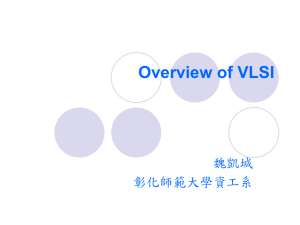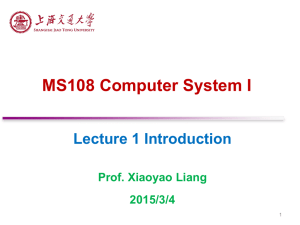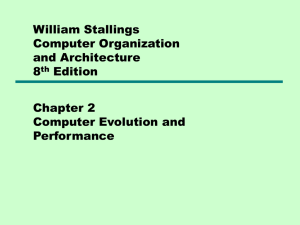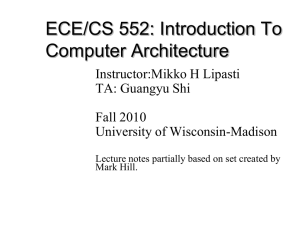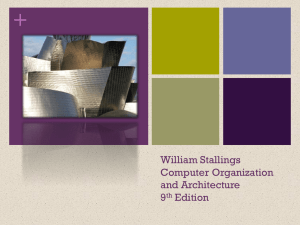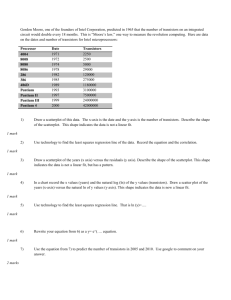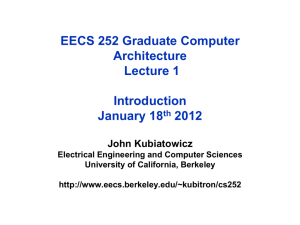CS598 LVK Parallel Programming with Migratable Objects
advertisement
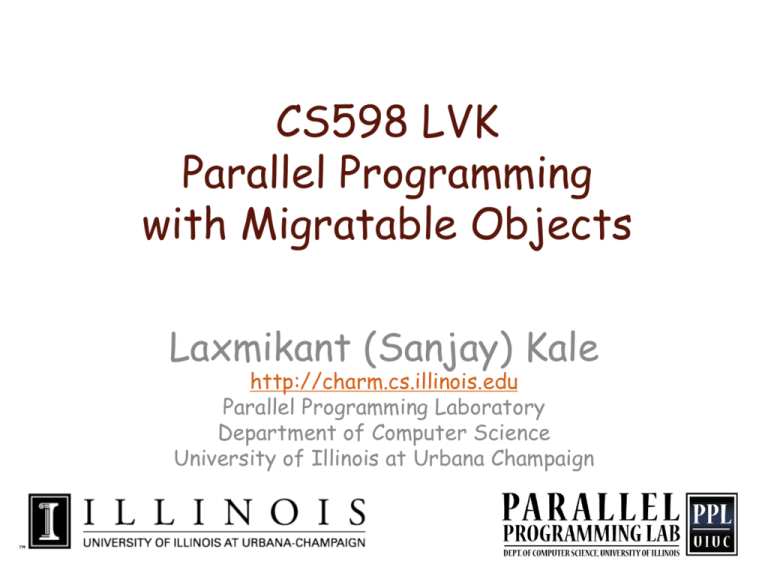
CS598 LVK Parallel Programming with Migratable Objects Laxmikant (Sanjay) Kale http://charm.cs.illinois.edu Parallel Programming Laboratory Department of Computer Science University of Illinois at Urbana Champaign Special topics class • We have an unexpectedly (but pleasantly) large class size • No Teaching Assistants! • A lot of responsibility for learning on you • Also: it is a class where you learn by doing 8/28/12 598Charm background 2 Class Format Lectures Reading papers or chapters Homeworks Programming assignments: 5-6 tentative Semester project: groups of 4 students A midterm exam, but with a small fraction of grade; no final exam • Tentative breakdown: • • • • • • 8/28/12 Homework Program. Midterm Assignments Exam Project 15% 30% 40% 15% 598Charm background 3 Computers • EWS workstations to begin with • Later: Taub cluster • (Hopes for Blue Waters are dashed with expected availability being probably too late for the class). • Taub is large enough 8/28/12 598Charm background 4 Course organization • On the web: • Engineering wiki page will be set up – https://wiki.engr.illinois.edu/display/cs598lvk • Backup page: – http://courses.engr.illinois.edu/cs598lvk • Lecture notes – (always pdf, some also in ppt) will be posted online • Homework assignments, updates: online • Newsgroup: class.fa12.cs598lvk hosted at news.cs.illinois.edu • You are responsible for checking these regularly 8/28/12 598Charm background 5 The Changing Landscape in Computing Laxmikant (Sanjay) Kale http://charm.cs.illinois.edu Parallel Programming Laboratory Department of Computer Science University of Illinois at Urbana Champaign Computers • We have been able to make a Machine that can do complex things • • • • Add and multiply really fast Weather forecast, design of medicinal drugs Speech recognition, Robotics, Artificial Intelligence.. Web browsers, internet communication protocols • What is this machine based on? 598Charm background 8/28/12 7 The Modest Switch • All these capabilities are built from an extremely simple component: – A controllable switch • The usual Electrical switch we use every day – The electric switch we use turns current on and off – But we need to turn it on and off by hand – The result of turning the switch on? • The top end in the figure becomes • raised to a high voltage • Which makes the current flow through the bulb • The Controllable Switch • No hands • Voltage controls if the switch is on or off • High voltage at input: switch on • Otherwise it is off 8/28/12 598Charm 8 background Lets use them creatively Output is high if both the inputs input1 AND input2 are high Input 1 Outp ut If either of the inputs is low, the output is low. This is called an AND gate Input 2 Now, can you make an OR gate with switches? 598Charm background 8/28/12 9 OR Gate Input1 Output Input2 Output is low iff both inputs are low 598Charm background 8/28/12 I.e. Output is high if either of the inputs (or both) are high (input1 OR input2) 10 Basic Gates • There are three basic kinds of logic gates Operation: AND of two inputs OR of two inputs NOT (complement) on one input Logic gate: • Two Questions: • How can we implement such switches? • What can we build with Gates? • Adders, controllers, memory elements, computers! 8/28/12 background 598Charm 11 How to make switches? • Use mechanical power • Use hydrolic pressure • Use electromechanical switches (electromagnet turns the switch on) • Current technology: – Semiconductor transistors • A transistor can be made to conduct electricity depending on the input on the 3rd input – CMOS gates (actually, switches) Two properties of Switches and Gates: Size 8/28/12 Switching and Propagation delay 598Charm12 background Clock Speeds • Since we can make transistors smaller – Which means smaller capacitances.. • Imagine filling up “tanks” with “water” (electrons) • We can turn them on or off faster – Which means we can make our computers go faster – Clock cycle is selected so that the parts of the computer can finish basic calculations within the cycle – And indeed: 8/28/12 598Charm background 13 The Virtuous Cycle • If you can make transistors smaller, – You can fit more of them on a chip • Cost per transistor decreases – AND: propagation delays get smaller • So they can run faster! • Can you make them smaller? – Technological progress needed, but can be done • This led to: – Cheaper and faster processors every year 8/28/12 598Charm background 14 Moore’s law • Commonly (mis) stated as – “Computer Performance doubles every 18 months” • Gordon Moore observed in 1965 – “The complexity… has increased roughly a factor of two per year. [It] can be expected to continue… for at least 10 years” – Its about number of transistors per chip • Funny thing is: it held true for 40+ years – And still going until 2020 – “Self Fulfilling prophecy” 8/28/12 598Charm background 15 8/28/12 598Charm background 16 Clock Speeds Increased Notice a little trick: x axis goes only to 2003! 8/28/12 598Charm background 17 Until they stopped increasing! Why? 8/28/12 598Charm background 18 Source: Herb Sutter (orig. in DDJ) 8/28/12 598Charm background 19 Prediction in 1999 From Shekhar Borkar, Intel, at MICRO 99 8/28/12 So, the chips were getting too hot 598Charm background 20 Prediction in 1999 From Shekhar Borkar, Intel, at MICRO 99 8/28/12 So, the chips were getting too hot 598Charm background 21 Bill Wulf in 1978 • William Wulf is one of the most influential computer scientist • Visited IISc Bangalore around 1978.. – When I was a grad student • Talked about his parallel computing projects – C.mmp – Stated motivations: Sequential processors cannot keep getting faster forever, because of physical limitations. We need many processors working in parallel to compute faster • But engineers kept making it go faster – Until now 8/28/12 598Charm background 22 Frequency and Power • There is a cubic relationship between them! – So, if frequency doubles, dynamic power increases 8-fold! – Static power is still a significant part of the total power • So, frequencies stalled around 2-3 GHz – Which is plenty fast 8/28/12 598Charm background 23 Power vs Frequency on a given processor !"#$%&'"()*+,-"(&./0& (&"#$$% (!"#$$% +,-./%01%23.45/.67% +,-./%8.9,%:"")$% +,-./%01%2;5,<=%>?0<@.7% ()"#$$% ($"#$$% '"#$$% &"#$$% !"#$$% (#)$% (#&$% )#$$% )#!$% )#'$% *#)$% *#&$% 1%$2*$(34&.5670& 8/28/12 598Charm background 24 Energy vs Frequency on a given processor ("(%$ +,-./$0.1,$2%%)!$ !"#$%&'()*+,-)#./+ ("(!$ +,-./$3#$45.67/.89$ ("!%$ +,-./$3#$4:7,;<$=>3;?.9$ ("!!$ !"'%$ !"'!$ !"&%$ !"&!$ !"#%$ !"#!$ (")!$ ("#!$ )")!$ )"#!$ *")!$ 0#)12)-3/+456(7+ 8/28/12 598Charm background 25 Number of Transistors/chip? • Well, they will keep on growing for the next ten years – May be a bit slowly • Current technology is 32 or 22 nanometers • We may go to 9 or 5 nanometers feature size – i.e. gap between two wires (as a simple definition) • For comparison: – Distance between a carbon and a Hydrogen atom is 1 Angstrom = 0.1 nanometer! – Silicon-Silicon bonds are longer – 5 Ao lattice spacing (image: wikipedia) • i.e. 0.5 nanometer – So, we are close to atomic units! 8/28/12 598Charm background 26 Consequence • • • • We will get to over 50 billion transistors/chip! What to do with them? Put more processors on a chip Beginning of the multicore era: – Number of cores per chip doubles every X years • X= 2? 3? 8/28/12 598Charm background 27 Change is changing • To summarize: – We had been used to computers becoming faster every year.. That “change” was a constant – The change is: that the speeds are no longer changing.. • So, Lets think about what happens over the next 10 years • And later: – What happens after ten years, when even the number of transistors don’t increase any more 8/28/12 598Charm background 28 Why didn’t we witness disruption? • Why haven’t we seen the effect of this disruption already? – After all the clocks stop speeding after 2003 • Better integration : – Intel’s Nehalem architecture • 4-way multicores could show useful performance gains for the users – Running multiple programs simultaneously – Browse, Index mail, virus scans, … • The real questions will appear in near future 8/28/12 598Charm background 29 Specialized processors • It was discovered that somewhat specialized processors can be made to compute (some things) faster, within the same technology – Vector instructions (SSE): • “Do these 4 additions” as a single instruction – IBM’s Cell processor (Toshiba, Sony) – NVIDIA GPGPU – Intel “maybe” LRB, MIC • It was assumed that people will not be willing to program specialized processors – NVIDIA proved them wrong – And time was right 8/28/12 598Charm background 30 Threat to business models • The previous were just ways in which processors can keep getting faster • But will people buy them? • Intel/AMD/.. Business model is fueled by people buying new machines every few years • Why do people buy new machines? – New apps need faster processors 8/28/12 598Charm background 31 Two problems • Maybe we have all the speed we need.. – I.e. for all the apps that we need – Nyah.. • Maybe 8-16 cores is all that you need – We are still seeing improvements because • We use multiple programs on the desktop • Browsers can do multiple things: get data, draw pictures, .. – But now, we have enough power.. Right? • So, unless one (or more) parallel “killer app” appears, the market will stop growing 8/28/12 598Charm background 32 What if we stop here? • Technical advantage (of Intel, AMD, NVIDIA) is no longer an advantage • Processor chips become commodity – Get manufactured wherever it is cheap • Innovation shifts elsewhere • Or more starkly stated: – Innovation in computing stops 8/28/12 598Charm background 33 Alternative: Parallelism • If we find killer apps that need all the parallel power we can bring to bear – With 50B transistors, at least 100+ processor cores on each chip • There is a tremendous competitive advantage to building such a killer app – So, given our history, we will find it • What are the enabling factors: – Finding the application areas. – Parallel programming skills 8/28/12 598Charm background 34 A few candidate areas • Some obvious ones: • Image processing: – Find all pictures of my daughter with a cat from all my albums • Already exists and will improve.. Parallelism is easy 8/28/12 598Charm background 35 More interesting areas • Speech recognition: – almost perfect already – But speaker dependent, minor training, and needs non-noisy environment – Frontier: speaker independent recognition with non-controlled environment • Broadly: Artificial intelligence • (Of course, HPC) 8/28/12 598Charm background 36 All Programming Becomes Parallel Programming 8/28/12 598Charm background 37 Parallel programming Skills • So, all machines will be (are?) parallel • So, almost all programs will be parallel – True? • There are 10 million programmers in the world – Approximate estimate • All programmers must become parallel programmers – Right? What do you think? 8/28/12 598Charm background 38 One way: Sequential-Parallel Separation • Our own example is a language called “Charisma” – or a simpler variant: structured dagger • A charisma Script captures parallel interactions • Sequential methods – consume data given to them, compute, and “publish” data – without knowing where it goes • You can decompose development into a team of parallel experts and domain experts.. – No “Joe Shmoe”s 8/28/12 598Charm background 39 Another Idea • Parallel programming is difficult – in large part because of race conditions, and nondeterministic behavior – Things may be complete in different orders than we expected – Its like relativity: no notion of “simultaneity” on a parallel machine – Result: a bug that manifests itself once in 10,000 runs • So, Outlaw non-determinism – Not quite like the Indiana legislature and Pi – Develop programming models that don’t allow it – Need to interoperate with languages that do • Our Examples: – MSA (Multiphase Shared Arrays), Charisma 8/28/12 598Charm background 40 Programming Models innovations • Expect a lot of novel programming models – There is scope for new languages, unlike now – Only Java broke thru after C/C++ • This is good news: – If you are a computer scientist wanting to develop new languages • Bad news: – If you are a application developer • DO NOT WAIT FOR “AutoMagic” Parallelizing compiler! 8/28/12 598Charm background 41 Digging Deeper • First law of holes: – If you in a hole, stop digging! • But we are in a hole, and we cannot help but dig! • Let me explain 8/28/12 598Charm background 42 Latency to Memory • To process data, we must bring it to the processor and take the resulting data back to memory • DRAM, the main inexpensive memory chip – Once you supply an address to it, it gets you the data after 50-ish nanoseconds • Doesn’t improve that much over time: 80 -> 30 ns – A single core clock is 2 GHz: it beats twice in a nanosecond! – So, you are working with someone who is 100 times slower.. – Not just that: a single core can do 4+ additions/cycle – We are talking about putting hundreds of cores on a chip?! 8/28/12 598Charm background 43 Latency vs bandwidth • Imagine you are putting a fire out – Only buckets, no hose – 100 seconds to walk with a bucket from water to fire, (and 100 to walk to walk back) – But if you form a bucket brigade • (needs people and buckets) – You can deliver a bucket every 10 seconds • So, latency is 100 or 200 seconds, but bandwidth is 0.1 buckets per second.. Much better – Whats more: you can increase bandwidth: • Just make more lines of bucket brigade 8/28/12 598Charm background 44 Bandwidth can be increased • • • • “Only” need resources But technology is going to help More pins can be added to chips 3D stacking of memory can increase bandwidth further 8/28/12 598Charm background 45 Exploiting bandwidth • Need methods that translate latency problems to bandwidth problems • The difference with bucket brigade analogy: – Data dependencies – If what mixture to ask in the next bucket depends on what happened using the last one – Solution: concurrency 8/28/12 598Charm background 46 Architectural methods • For translating latency problems to bandwidth problems • Ask for nearby data: Cache hierarchies • Ask for data in bulk (prefetch) and operate on it in bulk : cell processor • OR – Every cycle: work on one problem, send its memory request out, and switch to another problem – GPGPU (and before that, MTA, ..) 8/28/12 598Charm background 47 Impact on segments • • • • Mobile Laptop/desktop Small clusters Supercomputers 8/28/12 598Charm background 48 Mobile computing • Clients will get more powerful – Within same form factors.. – Of course, well connected • Your children will tell their children wistfully about text messaging.. – Because speech-to-text (and may be brain-toscreen) may become the norm • Headsets will whisper the name of the person walking towards you.. • Robots? 8/28/12 598Charm background 49 Laptops/Desktops • This is the big question mark • Depends on the parallel killer app • Of course, speech recognition, video processing will be there, as in mobile 8/28/12 598Charm background 50 Small Clusters • Probably some of the biggest impact • Broadening of the market • Every company/department can afford a very powerful (100 TF? PF?) cluster • All kinds of activities can be computerized – Intel’s example: • fashion designers examining how a cloth will drape over a body, and how it will move • Via simulation • Operations Research • Business Strategies via AI support 8/28/12 598Charm background 51 Supercomputers • Exascale will be reached by 2020 – May be 50 MW, and 10^18 ops/s • I expect – Will create breakthroughs in Science and Engineering of great societal impact – Biomedicine, materials, – Astronomy, Physics: theories – Engineering design of better artifacts – Control Nuclear fusion (fission) may solve energy problems – Climate?? • If society deems it beneficial, technology can be developed for beyond-exascale (1000 Eflops?) 8/28/12 598Charm background 52 Next Era: End of Moore’s Law • 10-15 years from now • No more increase in performance from a general purpose chip! • What can we predict about this era? – First, innovation would shift to functional specialization • would have started happening already – Next, innovation will shift to application areas, and molecular sciences: biomedical (nanobots?), materials, – Another 5-10 years, you can develop CSE applications knowing that machine won’t change under your feet • Maybe 8/28/12 598Charm background 53 Caution: predicting future • Remember: – 1900 or so: “End of Science” predicted – 1990 or so: “End of History” predicted 8/28/12 598Charm background 54 Summary • Times are changing: – I.e. they are getting more stagnant! • Those who can “get” parallel, will have an advantage • If killer parallel app doesn’t arrive, progress will stall • Complete “stasis” after 15-20 years.. – But then such things have been predicted before – 8/28/12 598Charm background 55

